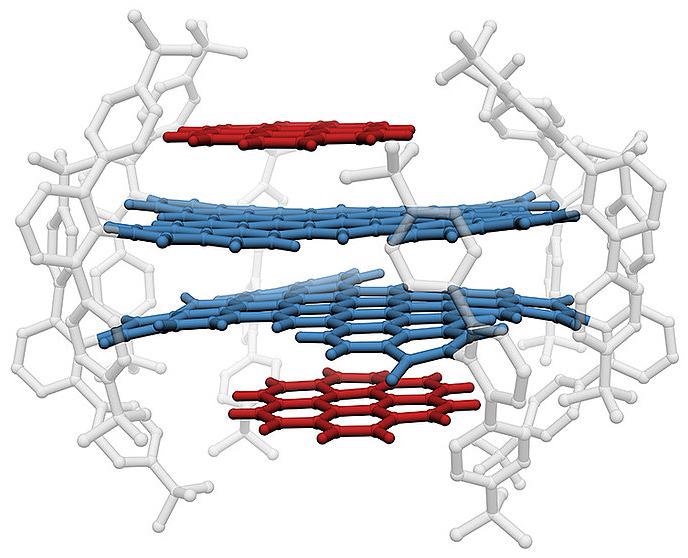Reviewed by Alex SmithFeb 8 2022
Numerous layers of nanographene are stacked on top of each other: These functional elements could one day be utilized in solar cells. Würzburg chemists have set the stage for this.
 Two nanographenes (blue) with bulky substituents (grey) have each attached a PAH (red) to give a quadruple dye stack. Image Credit: Arbeitsgruppe Würthner / Universität Würzburg.
Two nanographenes (blue) with bulky substituents (grey) have each attached a PAH (red) to give a quadruple dye stack. Image Credit: Arbeitsgruppe Würthner / Universität Würzburg.
Graphene, a carbon material, develops extremely thin layers. Due to its strange properties, it is used in several technical applications. This also applies to polycyclic aromatic hydrocarbons (PAHs), which are seen as cut-outs of graphene. They are believed to be encouraging materials for field-effect transistors or organic photovoltaics.
Large or single-layer PAH molecules—that are frequently described as nanographene—are well investigated. On the other hand, only a little information is available regarding PAHs arranged into columnar multilayer stacks.
Targeting Multilayer Nanographenes
Recently, a new approach has opened up for these materials: Scientists from Julius-Maximilians-Universität Würzburg (JMU) in Bavaria, Germany, presented an advanced technique for developing accurately defined and multilayered nanographene in the Nature Chemistry journal.
In our lab, we have synthesized a custom-made nanographene that is equipped with two cavities on both sides of its planar core.
Frank Würthner, Professor and Head, Centre for Nanosystems Chemistry, Julius-Maximilians-Universität Würzburg
The attachment of bulky substituents is responsible for the formation of cavities. Consequently, the nanographene has the ability to hold a maximum of two smaller PAHs on its top and bottom sides.
In the experiments carried out, the Würzburg chemists noted that the nanographene developed two- and three-layer PAH complexes in solution. Additionally, the team was able to detach pairs of such complexes as solids that is, as four- and six-layer PAHs, as well as other multilayer compounds.
The structural details of such products were verified by crystallographer Dr Kazutaka Shoyama. Doctoral students Magnus Mahl and M.A. Niyas accomplished the synthesis, supramolecular binding studies, and quantum-chemical calculations.
Possible Application in Solar Cells
Our concept for organizing multilayer nanographenes should be applicable to the design of functional organic materials.
Frank Würthner, Professor and Head, Centre for Nanosystems Chemistry, Julius-Maximilians-Universität Würzburg
Würthner states that this strategy of employing multilayer nanographenes for charge carrier generation in solar cells is encouraging.
This study was performed at the Institute of Organic Chemistry and the Centre for Nanosystems Chemistry at JMU. The German Research Foundation (DFG) offered financial support for the work (funding code WU 317/20-2).
Journal Reference:
Mahl, M., et al. (2022) Multilayer stacks of polycyclic aromatic hydrocarbons. Nature Chemistry. doi.org/10.1038/s41557-021-00861-5.